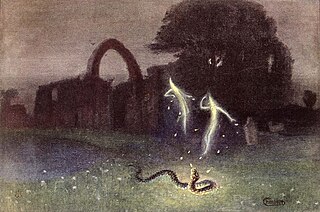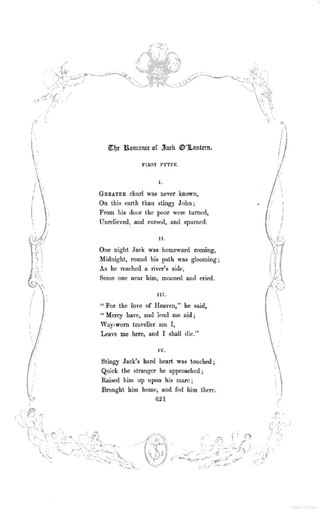
A nursery rhyme is a traditional poem or song for children in Britain and other European countries, but usage of the term dates only from the late 18th/early 19th century. The term Mother Goose rhymes is interchangeable with nursery rhymes.

A torch is a stick with combustible material at one end which can be used as a light source or to set something on fire. Torches have been used throughout history, and are still used in processions, symbolic and religious events, and in juggling entertainment. In some countries, notably the United Kingdom and Australia, "torch" in modern usage is also the term for a battery-operated portable light.

Mother Goose is a character that originated in children's fiction, as the imaginary author of a collection of French fairy tales and later of English nursery rhymes. She also appeared in a song, the first stanza of which often functions now as a nursery rhyme. The character also appears in a pantomime tracing its roots to 1806.

In folklore, a will-o'-the-wisp, will-o'-wisp, or ignis fatuus, is an atmospheric ghost light seen by travellers at night, especially over bogs, swamps or marshes.

A jack-o'-lantern is a carved lantern, most commonly made from a pumpkin, or formerly a root vegetable such as a mangelwurzel, rutabaga or turnip. Jack-o'-lanterns are associated with the Halloween holiday. Its name comes from the phenomenon of strange lights flickering over peat bogs, called jack-o'-lanterns. It is suggested that the name also has ties to the Irish legend of Stingy Jack, a drunkard who bargains with Satan and is doomed to roam the Earth with only a hollowed turnip to light his way.
Fairies, particularly those of Irish, English, Scottish and Welsh folklore, have been classified in a variety of ways. Classifications – which most often come from scholarly analysis, and may not always accurately reflect local traditions – typically focus on behavior or physical characteristics.

English folklore consists of the myths and legends of England, including the region's mythical creatures, traditional recipes, urban legends, proverbs, superstitions, dance, balladry, and folktales that have been passed down through generations, reflecting the cultural heritage of the country. This body of folklore includes a diverse array of characters, such as heroic figures like Beowulf or Robin Hood, legendary kings like Arthur, and mythical creatures like the Green Man and Black Shuck. These tales and traditions have been shaped by the historical experiences of the English people, influenced by the various cultures that have settled in England over centuries, including Celtic, Roman, Anglo-Saxon, Norse, and Norman elements.

"Ring a Ring o' Roses", also known as "Ring a Ring o' Rosie" or "Ring Around the Rosie", is a nursery rhyme, folk song, and playground game. Descriptions first appeared in the mid-19th century, though it is reported to date from decades earlier. Similar rhymes are known across Europe, with varying lyrics. It has a Roud Folk Song Index number of 7925.
The Denham Tracts constitute a publication of a series of pamphlets and jottings on folklore, fifty-four in all, collected between 1846 and 1859 by Michael Aislabie Denham, a Yorkshire tradesman. Most of the original tracts were published with fifty copies. The tracts were later re-edited by James Hardy for the Folklore Society and imprinted in two volumes in 1892 and 1895. It is possible that J.R.R. Tolkien took the word hobbit from the list of fairies in the Denham Tracts.

Apotropaic magic or protective magic is a type of magic intended to turn away harm or evil influences, as in deflecting misfortune or averting the evil eye. Apotropaic observances may also be practiced out of superstition or out of tradition, as in good luck charms, amulets, or gestures such as crossed fingers or knocking on wood. Many different objects and charms were used for protection throughout history.
Nickanan Night is a Cornish feast, traditionally held during Shrovetide, specifically on Shrove Monday.
Bucca is a male sea-spirit in Cornish folklore, a merman, that inhabited mines and coastal communities as a hobgoblin during storms. The mythological creature is a type of water spirit likely related to the Púca from Irish, the Pwca from Welsh folklore, and the female mari-morgans, a type of mermaid from Welsh and Breton mythology. Rev W. S. Lach-Szyrma, one 19th-century writer on Cornish antiquities, suggested the Bucca had originally been an ancient pagan deity of the sea such as Irish Nechtan or British Nodens, though his claims are mainly conjecture. Folklore however records votive food offerings made on the beach similar to those made to the subterranean Knockers and may represent some form of continuity with early or pre-Christian Brittonic belief practices.

"Fee-fi-fo-fum" is the first line of a historical quatrain famous for its use in the classic English fairy tale "Jack and the Beanstalk". The poem, as given in Joseph Jacobs' 1890 rendition, is as follows:

Cornish mythology is the folk tradition and mythology of the Cornish people. It consists partly of folk traditions developed in Cornwall and partly of traditions developed by Britons elsewhere before the end of the first millennium, often shared with those of the Breton and Welsh peoples. Some of this contains remnants of the mythology of pre-Christian Britain.

The Museum of Witchcraft and Magic, formerly known as the Museum of Witchcraft, is a museum dedicated to European witchcraft and magic located in the village of Boscastle in Cornwall, south-west England. It houses exhibits devoted to folk magic, ceremonial magic, Freemasonry, and Wicca, with its collection of such objects having been described as the largest in the world.

Stingy Jack O'Lantern, also known as Jack the Smith, Drunk Jack, Flaky Jack or Jack-o'-lantern, is a mythical character sometimes associated with All Hallows Eve while also acting as the mascot of the holiday. The "jack-o'-lantern" may be derived from the character.
Cecil Williamson was a British screenwriter, editor and film director and influential English Neopagan Warlock. He was the founder of both the Witchcraft Research Center which was a part of MI6's war against Nazi Germany, and the Museum of Witchcraft. He was a friend of both Gerald Gardner, who was the founder of Wicca, and also of the notorious occultist Aleister Crowley.

Cormoran is a giant associated with St. Michael's Mount in the folklore of Cornwall. Local tradition credits him with creating the island, in some versions with the aid of his wife Cormelian, and using it as a base to raid cattle from the mainland communities. Cormoran appears in the English fairy tale "Jack the Giant Killer" as the first giant slain by the hero, Jack, and in tales of "Tom the Tinkeard" as a giant too old to present a serious threat.

In folklore and literature, the Fairy Queen or Queen of the Fairies is a female ruler of the fairies, sometimes but not always paired with a king. Depending on the work, she may be named or unnamed; Titania and Mab are two frequently used names. Numerous characters, goddesses or folkloric spirits worldwide have been labeled as Fairy Queens.
"Torch Song" is a short story by John Cheever which first appeared in The New Yorker on October 4, 1947. The work was included in the short fiction collection The Enormous Radio and Other Stories (1953), published by Funk and Wagnalls. "Torch Song" is included in The Stories of John Cheever (1978).















